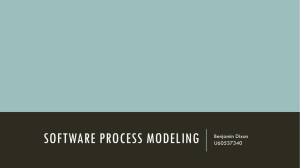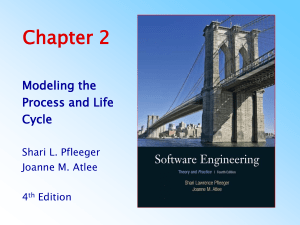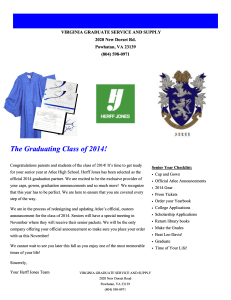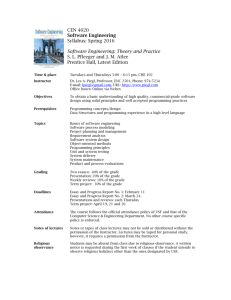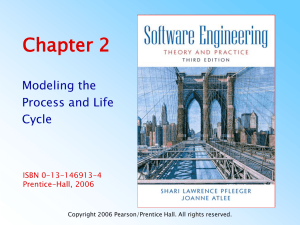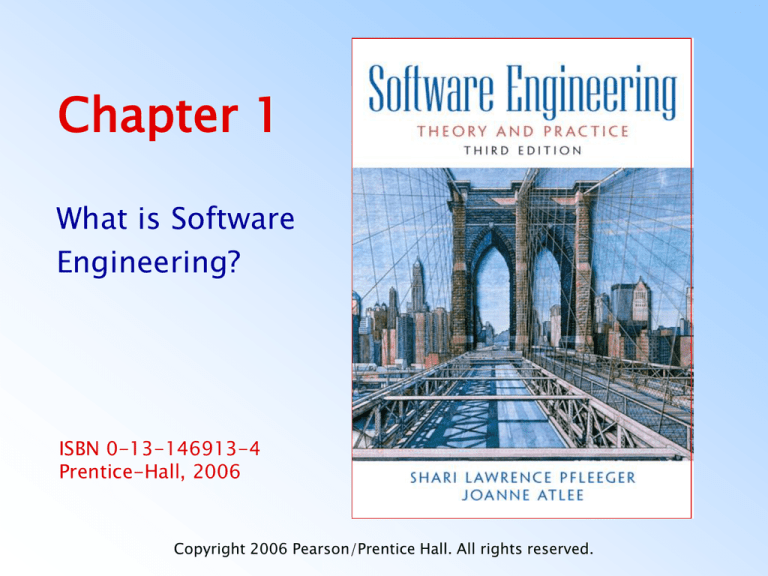
Chapter 1
What is Software
Engineering?
ISBN 0-13-146913-4
Prentice-Hall, 2006
Copyright 2006 Pearson/Prentice Hall. All rights reserved.
Contents
1.1
1.2
1.3
1.4
1.5
1.6
1.7
1.8
1.9
1.10
1.11
What is Software Engineering?
How Successful Have We Been?
What Is Good Software?
Who Does Software Engineering?
A Systems Approach
An Engineering Approach
Members of the Development Team
How Has Software Engineering Changed?
Information System Example
Real Time Example
What this Chapter Means for You
Pfleeger and Atlee, Software Engineering: Theory and Practice
© 2006 Pearson/Prentice Hall
Page 1.2
Objectives
•
•
•
•
•
What we mean by software engineering
Software engineering’s track record
What we mean by good software
Why a systems approach is important
How software engineering has changed since
the 1970s.
Pfleeger and Atlee, Software Engineering: Theory and Practice
© 2006 Pearson/Prentice Hall
Page 1.3
1.1 What is Software Engineering?
Solving Problems
• Software products are large and complex
• Development requires analysis and synthesis
– Analysis: decompose a large problem into
smaller, understandable pieces
• abstraction is the key
– Synthesis: build (compose) software from smaller
building blocks
• composition is challenging
Pfleeger and Atlee, Software Engineering: Theory and Practice
© 2006 Pearson/Prentice Hall
Page 1.4
1.1 What is Software Engineering?
Solving Problems (continued)
• The analysis process
Pfleeger and Atlee, Software Engineering: Theory and Practice
© 2006 Pearson/Prentice Hall
Page 1.5
1.1 What is Software Engineering?
Solving Problems (continued)
• The synthesis process
Pfleeger and Atlee, Software Engineering: Theory and Practice
© 2006 Pearson/Prentice Hall
Page 1.6
1.1 What is Software Engineering?
Solving Problems (continued)
• Method: refers to a formal procedure
• Tool: an instrument or automated system for
accomplishing something in a better way
• Procedure: a combination of tools and
techniques to produce a product
• Paradigm: philosophy or approach for
building a product
Pfleeger and Atlee, Software Engineering: Theory and Practice
© 2006 Pearson/Prentice Hall
Page 1.7
1.1 What is Software Engineering?
Where Does the Software Engineer Fit In?
• Computer science: focusing on computer
hardware and programming languages
• Software engineering: focusing on computer
as a problem-solving tool
Pfleeger and Atlee, Software Engineering: Theory and Practice
© 2006 Pearson/Prentice Hall
Page 1.8
1.1 What is Software Engineering?
Where Does the SW Engineer Fit in? (continued)
• Relationship between computer science and
software engineering
Pfleeger and Atlee, Software Engineering: Theory and Practice
© 2006 Pearson/Prentice Hall
Page 1.9
1.2 How Successful Have We Been?
• Perform tasks more quickly and effectively
– Word processing, spreadsheets, e-mail
• Support advances in medicine, agriculture,
transportation, multimedia education, and
most other industries
• However, software is not without problems
Pfleeger and Atlee, Software Engineering: Theory and Practice
© 2006 Pearson/Prentice Hall
Page 1.10
1.2 How Successful Have We Been?
Sidebar 1.1 Terminology for Describing Bugs
• A fault: occurs when a human makes a
mistake, called an error, in performing some
software activities
• A failure: is a departure from the system’s
required behaviour
Pfleeger and Atlee, Software Engineering: Theory and Practice
© 2006 Pearson/Prentice Hall
Page 1.11
1.2 How Successful Have We Been?
Examples of Software Failure
• IRS hired Sperry Corporation to build an automated
federal income tax form processing process
– An extra $90 M was needed to enhance the original $103
product
– IRS lost $40.2 M on interests and $22.3 M in overtime
wages because refunds were not returned on time
• Malfunctioning code in Therac-25 killed several
people
• Reliability constraints have caused cancellation of
many safety critical systems
– Safety-critical: something whose failure poses a threat to
life or health
Pfleeger and Atlee, Software Engineering: Theory and Practice
© 2006 Pearson/Prentice Hall
Page 1.12
1.3 What Is Good Software?
Sidebar 1.2 Perspective on Quality
• The transcendental view: quality is
something we can recognize but not define
• The user view: quality is fitness for purpose
• The manufacturing view: quality is
conformance to specification
• The product view: quality tied to inherent
product characteristics
• The value-based view: depends on the
amount the customers is willing to pay for it
Pfleeger and Atlee, Software Engineering: Theory and Practice
© 2006 Pearson/Prentice Hall
Page 1.13
1.3 What is Good Software?
• Good software engineering must always
include a strategy for producing quality
software
• Three ways of considering quality
– The quality of the product
– The quality of the process
– The quality of the product in the context of the
business environment
Pfleeger and Atlee, Software Engineering: Theory and Practice
© 2006 Pearson/Prentice Hall
Page 1.14
1.3 What Is Good Software?
The Quality of the Product
• Users judge external characteristics (e.g.,
correct functionality, number of failures, type
of failures)
• Designers and maintainers judge internal
characteristics (e.g., types of faults)
• Thus different stakeholders may have
different criteria
• Need quality models to relate the user’s
external view to developer’s internal view
Pfleeger and Atlee, Software Engineering: Theory and Practice
© 2006 Pearson/Prentice Hall
Page 1.15
1.3 What Is Good Software?
The Quality of the Product (continued)
• McCall’s quality model
Pfleeger and Atlee, Software Engineering: Theory and Practice
© 2006 Pearson/Prentice Hall
Page 1.16
1.3 What Is Good Software?
The Quality of the Process
• Quality of the development and maintenance
process is as important as the product
quality
• The development process needs to be
modeled
• Modeling will address questions such as
–
–
–
–
Where to find a particular kind of fault
How to find faults earlier
How to build in fault tolerance
What are alternative activities
Pfleeger and Atlee, Software Engineering: Theory and Practice
© 2006 Pearson/Prentice Hall
Page 1.17
1.3 What Is Good Software?
The Quality of the Process (continued)
• Models for process improvement
– SEI’s Capability Maturity Model (CMM)
– ISO 9000
– Software Process Improvement and Capability
dEtermination (SPICE)
Pfleeger and Atlee, Software Engineering: Theory and Practice
© 2006 Pearson/Prentice Hall
Page 1.18
1.3 What Is Good Software?
The Quality in the Context of the Business Environment
• Business value is as important as technical
value
• Business value (in relationship to technical
value) must be quantified
• A common approach: return on investment
(ROI) – what is given up for other purposes
• ROI is interpreted in different terms:
reducing costs, predicting savings,
improving productivity, and costs (efforts
and resources)
Pfleeger and Atlee, Software Engineering: Theory and Practice
© 2006 Pearson/Prentice Hall
Page 1.19
1.3 What Is Good Software?
The Quality of the Context of the Business Environment
• Industry’s view of ROI
Pfleeger and Atlee, Software Engineering: Theory and Practice
© 2006 Pearson/Prentice Hall
Page 1.20
1.4 Who Does Software Engineering?
• Customer: the company, organization, or
person who pays for the software system
• Developer: the company, organization, or
person who is building the software system
• User: the person or people who will actually
use the system
Pfleeger and Atlee, Software Engineering: Theory and Practice
© 2006 Pearson/Prentice Hall
Page 1.21
1.4 Who Does Software Engineering?
(continued)
• Participants (stakeholders) in a software
development project
Pfleeger and Atlee, Software Engineering: Theory and Practice
© 2006 Pearson/Prentice Hall
Page 1.22
1.5 Systems Approach
• Identify activities and objects
• Define the system boundary
• Consider nested systems, systems
interrelationship
Pfleeger and Atlee, Software Engineering: Theory and Practice
© 2006 Pearson/Prentice Hall
Page 1.23
1.5 Systems Approach
The Element of a System
• Activities and objects
– An activity is an event initiated by a trigger
– Objects or entities are the elements involved in
the activities
• Relationships and the system boundaries
– A relationship defines the interaction among
entities and activities
– System boundaries determine the origin of input
and destinations of the output
Pfleeger and Atlee, Software Engineering: Theory and Practice
© 2006 Pearson/Prentice Hall
Page 1.24
1.5 Systems Approach
The Elements of a System (continued)
• Example of systems: a human respiratory
system
Pfleeger and Atlee, Software Engineering: Theory and Practice
© 2006 Pearson/Prentice Hall
Page 1.25
1.5 Systems Approach
The Element of a System (continued)
• A computer system must also be clearly
described: System definition of a paycheck
production
Pfleeger and Atlee, Software Engineering: Theory and Practice
© 2006 Pearson/Prentice Hall
Page 1.26
1.5 Systems Approach
Interrelated Systems
• Some systems are dependent to other
systems
– The interdependencies may be complex
• It is possible for one system to exist inside
another system
• If the boundary definitions are detailed,
building a larger system from the smaller
ones is relatively easy
Pfleeger and Atlee, Software Engineering: Theory and Practice
© 2006 Pearson/Prentice Hall
Page 1.27
1.5 Systems Approach
Interrelated Systems (continued)
• A layered system
Pfleeger and Atlee, Software Engineering: Theory and Practice
© 2006 Pearson/Prentice Hall
Page 1.28
1.6 Engineering Approach
Building a System
•
•
•
•
•
•
•
•
•
Requirements analysis and definition
System design
Program design
Writing the programs
Unit testing
Integration testing
System testing
System delivery
Maintenance
Pfleeger and Atlee, Software Engineering: Theory and Practice
© 2006 Pearson/Prentice Hall
Page 1.29
1.7 Members of the Development Team
• Requirement analysts: work with the customers to
identify and document the requirements
• Designers: generate a system-level description of
what the system us supposed to do
• Programmers: write lines of code to implement the
design
• Testers: catch faults
• Trainers: show users how to use the system
• Maintenance team: fix faults that show up later
• Librarians: prepare and store documents such as
software requirements
• Configuration management team: maintain
correspondence among various artifacts
Pfleeger and Atlee, Software Engineering: Theory and Practice
© 2006 Pearson/Prentice Hall
Page 1.30
1.7 Members of the Development Team
(continued)
• Typical roles played by the members of a
development team
Pfleeger and Atlee, Software Engineering: Theory and Practice
© 2006 Pearson/Prentice Hall
Page 1.31
1.8 How Has Software Engineering Changed?
The Nature of the Change
• Before 1970s
– Single processors: mainframes
– Designed in one of two ways
• as a transformation: input was converted to output
• as a transaction: input determined which function
should be performed
• After 1970s
– Run on multiple systems
– Perform multi-functions
Pfleeger and Atlee, Software Engineering: Theory and Practice
© 2006 Pearson/Prentice Hall
Page 1.32
1.8 How Has SE Changed?
Wasserman's Seven Key Factors
•
•
•
•
•
Criticality of time-to-market
Shifts in the economics of computing
Availability of powerful desktop computing
Extensive local- and wide-area networking
Availability and adoption of object-oriented
technology
• Graphical user interfaces
• Unpredictability of the waterfall model of
software development
Pfleeger and Atlee, Software Engineering: Theory and Practice
© 2006 Pearson/Prentice Hall
Page 1.33
1.8 How Has SE Changed?
Wasserman's Seven Key Factors (continued)
• The key factors that have changed the
software development
Pfleeger and Atlee, Software Engineering: Theory and Practice
© 2006 Pearson/Prentice Hall
Page 1.34
1.8 How Has SE Changed?
Wasserman's Discipline of Software Engineering
•
•
•
•
•
•
•
•
Abstraction
Analysis and design methods and notations
User interface prototyping
Software architecture
Software process
Reuse
Measurement
Tools and integrated environments
Pfleeger and Atlee, Software Engineering: Theory and Practice
© 2006 Pearson/Prentice Hall
Page 1.35
1.8 How Has SE Changed?
Abstraction
• A description of the problem at some level of
generalization
– Hide details
Pfleeger and Atlee, Software Engineering: Theory and Practice
© 2006 Pearson/Prentice Hall
Page 1.36
1.8 How Has SE Changed?
Analysis and Design Methods and Notations
•
•
•
•
Provide documentation
Facilitate communication
Offer multiple views
Unify different views
Pfleeger and Atlee, Software Engineering: Theory and Practice
© 2006 Pearson/Prentice Hall
Page 1.37
1.8 How Has SE Changed?
User Interface Prototyping
• Prototyping: building a small version of a
system
– Help users identify key requirements of a system
– Demonstrate feasibility
• Develop good user interface
Pfleeger and Atlee, Software Engineering: Theory and Practice
© 2006 Pearson/Prentice Hall
Page 1.38
1.8 How Has SE Changed?
Software Architecture
• A system’s architecture describes the system
in terms of a set of architectural units and
relationships between these units
• Architectural decomposition techniques
–
–
–
–
–
Modular decomposition
Data-oriented decomposition
Event-driven decomposition
Outside-in-design decomposition
Object-oriented decomposition
Pfleeger and Atlee, Software Engineering: Theory and Practice
© 2006 Pearson/Prentice Hall
Page 1.39
1.8 How Has SE Changed?
Software Process
• Many variations
• Different types of software need different
processes
– Enterprise-wide applications need a great deal of
control
– Departmental applications can take advantage of
rapid development
Pfleeger and Atlee, Software Engineering: Theory and Practice
© 2006 Pearson/Prentice Hall
Page 1.40
1.8 How Has SE Changed?
Software Process (continued)
• Pictorial representation of differences in
development processes
Pfleeger and Atlee, Software Engineering: Theory and Practice
© 2006 Pearson/Prentice Hall
Page 1.41
1.8 How Has SE Changed?
Software Reuse
• Commonalities between applications may
allow reusing artifacts from previous
developments
– Improve productivity
– Reduce costs
• Potential concerns
– It may be faster to build a smaller application
than searching for reusable components
– Generalized components take more time to build
– Must clarify who will be responsible for
maintaining reusable components
– Generality vs specificity: always a conflict
Pfleeger and Atlee, Software Engineering: Theory and Practice
© 2006 Pearson/Prentice Hall
Page 1.42
1.8 How Has SE Changed?
Measurement
• Using measurement to help find a solution
Pfleeger and Atlee, Software Engineering: Theory and Practice
© 2006 Pearson/Prentice Hall
Page 1.43
1.8 How Has SE Changed?
Tools and Integrated Environments
• Platform integration (on heterogeneous
networks)
• Presentation integration (commonality of
user interface)
• Process integration (linking tools and the
development process)
• Data integration (to share common data)
• Control integration (the ability of one tool to
initiate action in another one)
Pfleeger and Atlee, Software Engineering: Theory and Practice
© 2006 Pearson/Prentice Hall
Page 1.44
1.9 Information System Example
Piccadilly System
• Piccadilly Television: regional British TV
franchise
• Advertising scheme has many constraints:
– alcohol adverts only after 9pm
– if actor in show, no same actor in advert within 45
minutes
– if advert in class of product, no other advert in
same class during same break
– rates dependent on amount of time bought
• Software to determine, track advertising time
Pfleeger and Atlee, Software Engineering: Theory and Practice
© 2006 Pearson/Prentice Hall
Page 1.45
1.9 Information System Example
Piccadilly System (continued)
• Piccadilly Television franchise area
Pfleeger and Atlee, Software Engineering: Theory and Practice
© 2006 Pearson/Prentice Hall
Page 1.46
1.9 Information System Example
Piccadilly System (continued)
• Piccadilly system’s context diagram
Pfleeger and Atlee, Software Engineering: Theory and Practice
© 2006 Pearson/Prentice Hall
Page 1.47
1.10 Real Time Example
• Ariane-5 rocket, from the European Space
Agency
• June 4, 1996: functioned well for 40
seconds, then veered off course and was
destroyed
• Contained four satellites: cost was $500
million
• Reused code from Ariane-4 rocket
Pfleeger and Atlee, Software Engineering: Theory and Practice
© 2006 Pearson/Prentice Hall
Page 1.48
1.10 Real Time Example
Ariane-5 Definition of Quality
• From the Lions et al report:
– “… demonstrated the high quality of the Ariane-5
programme as regards engineering work in
general and completeness and traceability of
documents.”
– “… the supplier of the SRI … was only following
the specification given to it. … The exception
which occurred was not due to random failure but
a design error.”
Pfleeger and Atlee, Software Engineering: Theory and Practice
© 2006 Pearson/Prentice Hall
Page 1.49
1.11 What this Chapter Means for You
• Given a problem to solve
– Analyze it
– Synthesize a solution
• Understand that requirements may change
• Must view quality from several different
perspectives
• Use fundamental software engineering
concepts (e.g., abstractions and
measurements)
• Keep system boundary in mind
Pfleeger and Atlee, Software Engineering: Theory and Practice
© 2006 Pearson/Prentice Hall
Page 1.50


